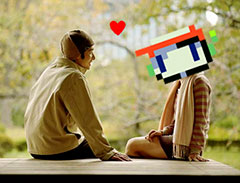Contrary to an easy pun on his last name, Simon Carless is all but careless when answering interview questions. I must admit that his diplomatic flair was a bit frustrating at times to an amateur interviewer like myself. He even refused to answer some questions.
But I am mostly pleasantly surprised by his optimism, enthusiasm and generosity towards independent games. There’s a reason why he is chairman of the Independent Games Festival! Even if other activities, both as Publisher of Game Developer magazine and Gamasutra.com and the excellent GameSetWatch blog, take up more and more of his time.
We’re thankful that he took the time to give us a rare insight in his well-informed opinions and deep understanding of the more exciting side of the games industry.
Music, game design, journalism, business
ToT: In the past, you have designed games for Eidos and Atari. But nowadays you seem to be mostly active as a journalist. Are you still designing games or thinking about designing games? Or have you found a new vocation? And if the later, what motivates you?
SC: I’m actually moving out from being a journalist a little further into the business end of things – I still run GameSetWatch as my own journalism-style project, but I’m gradually shifting to be the business/product manager for Game Developer magazine, Game Developer Research, Gamasutra, and the Independent Games Festival/Summit, helping shape the future of all those products. Though I can still hang with the editors, obviously, and make impertinent suggestions!
As for whether I still design games, well – it’s odd. I actually used to be a musician in the Amiga demo-scene, and I got hired into game design at an established company (Simis, now Kuju Entertainment) after I graduated from university, so I only really ever worked on commissioned projects. Since I can’t code, and I don’t feel like designing games on paper which won’t be implemented by anyone, I don’t really think about designing right now. Even when I worked as a designer/writer in the industry, I liked talking about the industry – I’ve been writing for Gamasutra for 10 years now, even though I’ve only been working here for about 3. I loved my time as a designer, but I think I’m best suited to what I’m doing now – which is more dealing with the business of games than actually making them.
Independent Games Festival, Summit and Mobile
ToT: Are you still involved with the Independent Games Festival? Can you tell us a bit more about the hopes and ambitions of the festival?
SC: I’m still Chairman of the Independent Games Festival, yes, although Matthew Wegner and Steve Swink (former IGF finalists with Flashbang Studios) are Content Directors this year, helping me out while I fulfil some of my other obligations running CMP’s game magazine and websites. But we’ve been working really closely together for IGF this year, and there’s again $50,000 in prizes to give away, plus an awesome opportunity to showcase your game to the world at Game Developers Conference in February 2008.
“It’s becoming clear that indie games are getting higher and higher profile, selling more copies, and becoming more relevant to the public at large.”
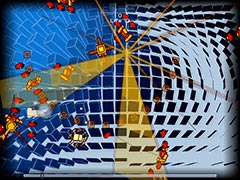
Still from Jonathan Mak’s “Everyday Shooter”
Following a lot of the excitement last year, with Queasy Games’ Everyday Shooter getting picked up by Sony and Bit-Blot’s Aquaria getting so much positive press (and, indeed, Student finalist The Blob being signed by THQ for a Wii version), it’s becoming clear that indie games are getting higher and higher profile, selling more copies, and becoming more relevant to the public at large. This is vitally important, because while we’d all love to not worry about the monetization angle, getting indie games to a sound financial footing is the one thing that will fuel the coming explosion – and it’s happening as we speak. This means there’s some great art spiraling out of the whole boom – which is wonderful, and is getting us much closer to the Sundance model – where finalists care about the exposure because it will lead to something major.
Also, we’re going to be running the Independent Games Summit again at GDC 2008, since the first one was sold out and really well received – check out the site if you want to see videos from the first summit, which we’re gradually adding there. Again, we’re going to get the leading lights of the indie scene together to talk about where we are and where we’re going, from artistic and many other standpoints. It’s going to be really, really interesting.
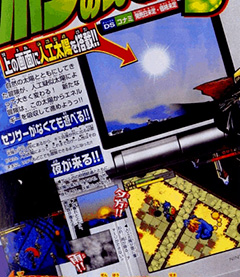
“Boktai” finds playful uses for sunshine.
And finally, we just started up something new – IGF Mobile, which is a sister competition which Nvidia has stepped forward to fund for multiple years, because they want to foster innovation in mobile games – whether it be for cellphones, DS, PSP or any other devices – with $20,000 in prizes for the first year. Why should people care about the sometimes staid mobile angle? Borrowing from a GameSetWatch post I wrote about this:
“There are two or three angles from which this sister IGF competition should be good for indie developers. Firstly, there really are some great overlooked cellphone games out there – from developers like Capybara Games and others – which these awards should highlight in the context of GDC and the Independent Games Festival. Secondly, there’s the DS, PSP and other handhelds angle – and there are plenty of prototypes or homebrew-like games out there which deserve honoring – heck, maybe that Shantae DS title I was drooling over the other day will enter.
Finally – and this is the particularly interesting ‘augmented’ angle – there are all kinds of cool game design things you can do if you have a handheld device and other add-ons such as GPS, a camera, Internet connectivity and so on.
A few examples from games big and small – Final Fantasy: Before Crisis for cellphones had a camera-based materia collecting feature, in which: “The goal is to photograph something that contains the predefined colors that will produce new materia. For example, photographing something that is predominantly red will yield a Fire materia.” Awesome idea. Elsewhere, there’s other neat concepts like the solar sensor in Konami’s Boktai and even Gizmondo’s (!) augmented reality project, using the camera and overlaying computer-generated art based on a grid.”
So as you can see, there’s some really interesting possibilities there, and I think handheld games have a big opportunity for indies, given that you’re hardly going to be making Halo 3-size experiences for most handhelds either – so the medium (and particularly the DS) is incredibly well suited for indie-size teams. But the normal Independent Games Festival will continue to run alongside it, with all the same prizes and great entries – so it’s just more goodness, really.
Thriving Independence
Tale of Tales (ToT): To relative newcomers like ourselves, the independent games scene seems to be thriving and growing rapidly at the moment, both in size and importance. Is this a correct observation? And if so, what do you think are the reasons for this recent flourishing?
Simon Carless (SC): I think the ‘independent games scene’ is indeed flourishing, which is a wonderful thing to see. There are a number of reasons for that. Firstly, on the higher end, a lot of veteran creators of high-end console and PC games are creating their own small development teams to make console/PC downloadable games or even lower-budget DS and Wii titles. While this is sometimes a little more professional than some people consider ‘indie’ to be, it’s actually a really important part of the independent ecosystem – the first Independent Games Summit that we ran at GDC this year had a number of people who fit into that particular category.
“Being an indie game creator is a really interesting place to be right now.”
In addition, ‘bedroom programmers’, student game developers and first-time creators from outside the industry are using the Web to distribute their games, get noticed, and build a following – titles like Armadillo Run and N are great examples of games that have built up a community around them. Even beyond that, there’s a flourishing indie journalism community, bigger websites are really taking notice of some indie downloadable and Flash titles, and there’s significant indie/casual crossover into the big casual PC game portals, too. So all in all – being an indie game creator is a really interesting place to be right now.
ToT Many people often refer to innovation as part of the value of the indie games scene, but frankly I can’t see that. There’s definitely not more innovative indie games than there are innovative “commercial” games. On the contrary. Indie games are often explicitly retro! How do you see this marriage between a clear reactionary attitude and the claims of innovation?
SC: There was an absolutely awesome talk at the Independent Games Summit (sister to the IGF) this year about innovation, written up here, actually: http://www.gamasutra.com/php-bin/news_index.php?story=12995
I’m just going to cite what a couple of the speakers said, since they’re talented indies and say it a lot better than I could:
“Jon Mak, who created the IGF-nominated Everyday Shooter, maintained that innovation is not what’s important in the games industry. He thinks that while mainstream game makers have a problem in being the same as everyone else, indies have a problem in trying to be different. “It’s still based on what everyone else thinks.” Mak believes independent game developers should strive to make “pieces based on your heart and not the hearts of a thousand others.”
Jonathan Blow continued along the lines of the previous presenters, by stating that innovation is not required for a work to be great. In fact, innovation can be used just to distract the audience, in which case it’s merely a gimmick. Gimmicks don’t create great art.
“But even the mainstream game industry can’t do gimmicks, and isn’t that sad?” For Blow, innovation is important because it helps the game industry explore new territory, and working within this explored territory is no bad thing.”
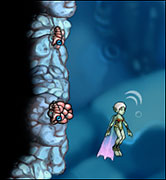
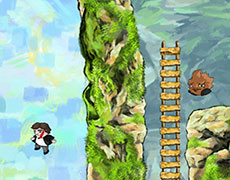
“Aquaria” by Bit Blot and Jonothan Blow’s “Braid”
have both been winners at the IGF in previous years.
Like independent films?
ToT: The commercial games industry, for better or for worse, is becoming more and more like the commercial film industry, delivering conservative products with a high degree of polish and spectacle. How close is the indie games scene to becoming the games industry’s equivalent of independent films?
SC: I think you can divide game industry products quite simply by size of budget. If you’re making a PlayStation or Xbox 360 title, with budgets often exceeding U.S. $15 million dollars, then you’re going to need to appeal to a wide range of people – you might need to sell 1 million copies worldwide to break even on titles like this, taking into account marketing costs and so on. So many business decisions factor into the game’s production – does it need to be made quickly to time with a movie release, does it need to be accessible by having similar gameplay to previous titles, and so on? It certainly leads to conservatively designed games, because the game’s publishers want their money back.
“The indie community should be using publishers’ money to get onto consoles more aggressively.”
However, for lower-budget titles, particularly for digital download and on Nintendo’s DS and Wii platforms, I think you’re seeing a degree of latitude quickly seeping in from the commercial games industry. Why? Well, if a DS title can cost significantly less than $1 million in some cases, the firm’s break-even point is a lot closer to 50-100,000 units (if everything is done inexpensively), so even large firms are quite happy to try a few diverse, more individual titles and take some risks. In fact, I think that the indie community should be using publishers’ money to get onto consoles more aggressively – a lot of the best indie films are at least partially funded by money from bigger studios, after all.
But on the lower end, it’s totally possible to make great indie games on your own or with a friend, in your home or a bedroom, distribute them online, and make enough money to devote your time to making more games. Or maybe you don’t care about the money, even! Really, some of the best indie games are just created by people in their spare time – and this is very different from the movie industry, because you can’t quite get professional quality movies just from someone noodling in their spare time. So it puts indie games in a great position, if you ask me.
ToT: Is this really true? Can people really make enough money off of indy games to make a living? Can you name any examples of this phenomena other than Introversion?
SC: Of course! Technically they have an office, but Gastronaut did Small Arms for Xbox Live Arcade at basically a couple of people and their dogs in an office, plus external help. Jeff Minter has completed Space Giraffe with one fellow programmer from a Welsh farm. Flash games like Tower Defense are beginning to make lots of advertising revenue – enough for a standalone income. Peter Stock did Armadillo Run entirely on his own and is subsisting off it. There are plenty of casual games done by small indie developers that make decent money. Up to recently, the PC indie scene just wasn’t big enough to make this very easy – but it’s gradually, gradually getting there, thanks to income from Web games, casual games, and console digital distribution, the dream is alive.
ToT: Independent films are often artistic films. Independent games hardly ever. The focus remains firmly on fun and entertainment. We are far removed from a game “d’auteur”, let alone a “nouvelle vague” of sorts that inspires the mainstream. Do you see an artistic awakening of the games medium on the horizon? And will that happen within the independent games?
SC: Well, I think you need to be careful here. ‘artistic’ is an awfully prejudical term when talking about indie films, in some ways. I think new, innovative gameplay mechanisms are just as much ‘artistic’ as a particularly evocative movie storyline – just in a different way. I’m not sure really what ‘Independent films are often artistic films’ is meant to mean, actually. There are plenty of independent films that, say, star Anna Nicole Smith, or are splatter gore pics, or are just terrible small-town productions. I think you see my point.
“What we need is more personal games.”
But referencing Jon Mak’s comments above – I think what we need is more personal games. Personal games may not have overarching stories, and may not necessarily have a message, and they may just be mindless and fun! But they are what the game creator intended to make, based on his personal vision, or the personal vision of just a small amount of people working closely together. I feel confident that the more this happens, the more we’ll get games that fulfil all eventualities – those that make you laugh, and think, and thrill, and even make you sad or think about personal and emotional issues – which is what some people expect the game scene to tend towards as some kind of Utopian dream, I think. To me, it’s just one of the many strands – albeit one that needs to be explored a lot more.
Interview conducted via email by Michaël Samyn between June and October 2007. The text has been rearranged a bit for readability.


